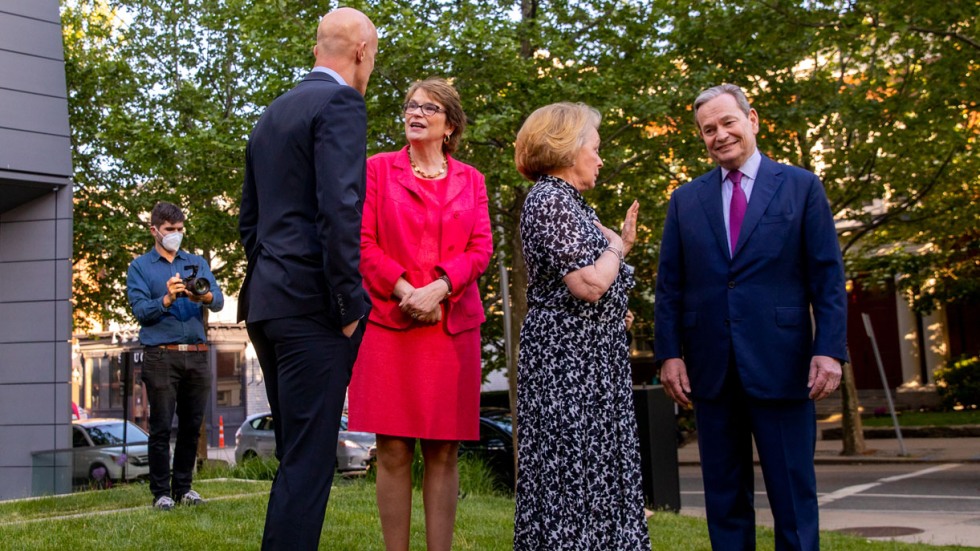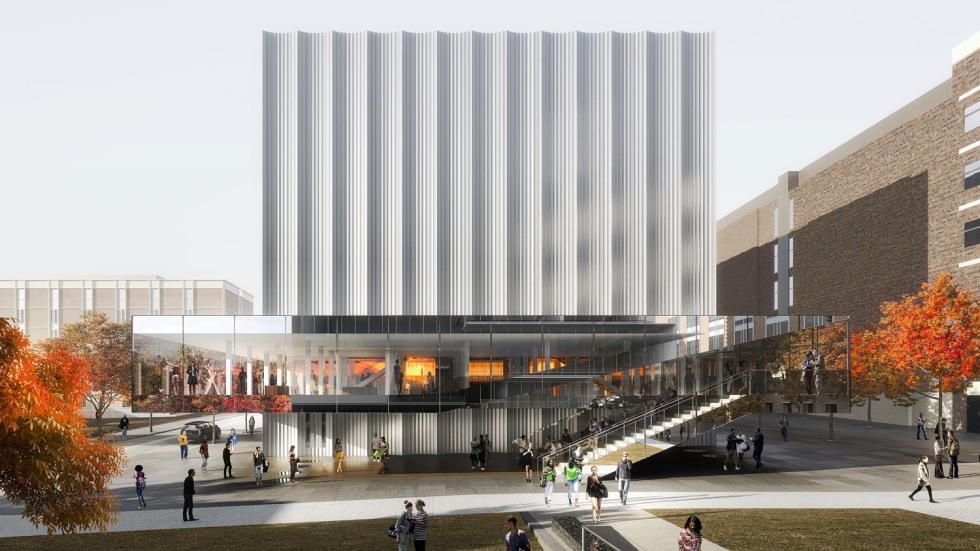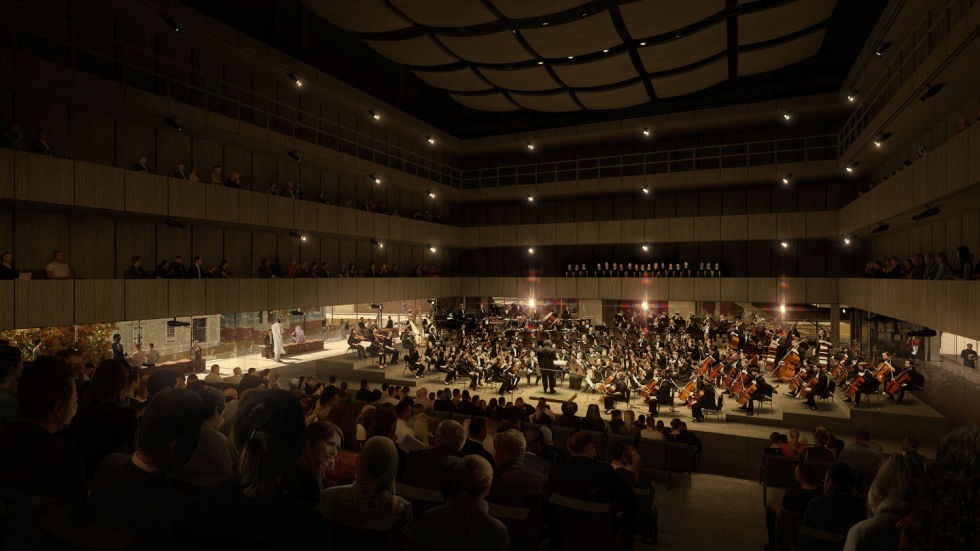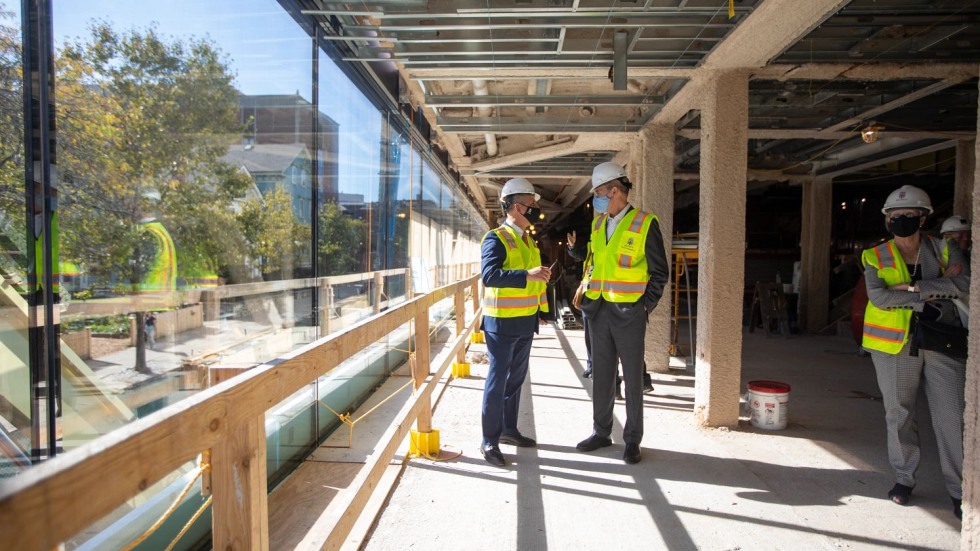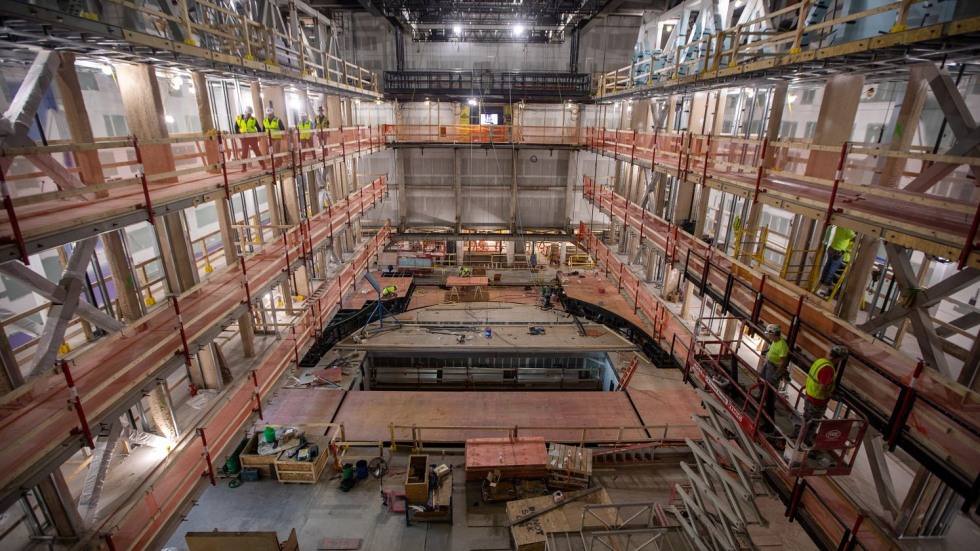Brown names The Lindemann Performing Arts Center
Brown University will name its new state-of-the-art performance venue The Lindemann Performing Arts Center.
The center’s name recognizes a generous gift from Frayda B. Lindemann — a Brown University trustee, proud Brown parent and grandparent, and president and CEO of the board of directors at the Metropolitan Opera in New York — alongside her late husband, George Lindemann Sr., a longtime University benefactor, business executive and art collector who died in 2018.
The Lindemann Performing Arts Center, slated to open in the heart of Brown’s campus in fall 2023, will build on the University’s reputation as a premier destination for cutting-edge scholarship and performance in many artistic disciplines, including music, theater, dance, literary art, visual art and multiple kinds of experimental collaborations.
The Lindemanns are providing crucial support for the construction and operation of the unique, flexible space, which features a state-of-the-art main hall that can transform into five different configurations for a variety of performances and presentations; a suite of modern studios custom-designed for theater, music, dance and other artistic explorations; and a transparent “slice” of windows through the main level that invites the Brown and Providence communities to witness and engage in the artmaking process.
The center’s name was unveiled on Tuesday, May 24, during a small celebration with University leaders, faculty and staff from the Brown Arts Institute, and members of the Lindemann family. The building’s name is visible to passersby in Providence, etched into the façade of the building where construction continues on Angell Street, adjacent to the Granoff Center for the Creative Arts.
According to University President Christina H. Paxson, with the opening of The Lindemann Performing Arts Center on the horizon, Brown is positioned to become a top destination for world-class arts scholars, students committed to the arts, international artists and regional community members who will be invited to make, present and witness work in the new center. The center’s placement next to the Granoff Center creates a strong hub on campus for creativity, expression, experimentation and discovery.
“We see a future where Brown is the primary destination for students who want to fully integrate the arts into a complete education, and The Lindemann Performing Arts Center is an important part of that vision,” Paxson said. “By supporting artistic scholarship and innovation in this truly one-of-a-kind space, Frayda Lindemann is helping the University create a distinctive home for generations of talented students, faculty, community members and visiting artists.”
Mrs. Lindemann said that before her husband died, he was looking forward to supporting the Performing Arts Center project, which will expand Brown’s ability to create and stage new and existing works, combine art forms and welcome world-renowned faculty and artists to learn from and inspire students across disparate fields of study. She said that she and Paxson share a belief that the arts play a critical role — not only in higher education settings but also in communities everywhere.
“The arts are what make us human and separate us from other species,” Mrs. Lindemann said. “Science, technology and medicine are crucially important to furthering innovation and saving lives, it’s true — but music, fine art, dance and theater are equally important, because they help us remember our humanity.”
When completed, the center’s main hall will boast moveable walls, floors, seats, curtains, ceiling and lights — giving University and community artists the option to have the space tailored to their specific structural, aesthetic and acoustic needs. The building will also feature a 13-foot horizontal windowed “clearstory” that slices through the main level, revealing the interior of the main hall and the Diana Nelson and John Atwater Lobby to passersby in every direction.
“The 23rd-century vision for a performance hall that has walls that move will be a remarkable asset to the boundlessly creative students and arts faculty at Brown,” Mrs. Lindemann said. “And I’m intrigued by how the transparent, lit-up main floor will enable community members at Brown and in Providence to see their peers create exciting performances as they walk by. When you see art getting made, you feel something — you leave the day-to-day of our world and enter a special place.”
In addition to the range of configurations available in the center’s main hall — from a 625-seat symphony orchestra hall, to a 250-seat proscenium theater, to an immersive surround-sound cube for experimental media and a flat-floor configuration for film or visual art installations — a suite of modern studios, rehearsal spaces and intimate performance venues custom-designed for theater, music, dance and other art forms will serve as everyday academic resources for Brown students and faculty.
Avery Willis Hoffman, artistic director of the Brown Arts Institute, said that thanks in large part to the Lindemann family’s generosity, the center is sure to inspire future generations of student, faculty and community artists to create cutting-edge, original artwork and re-examine well-known works, practices and traditions. Hoffman said that in addition to world-class projects by international visiting artists, The Lindemann Performing Arts Center will host the work of artists, performers and scholars in Brown’s six arts departments and Rites and Reason Theatre, all of whom are affiliated with the BAI.
“This investment in the PAC is also an investment in the BAI,” Hoffman said. “It enables the BAI to dream even bigger as we fulfill our goals of cultivating creative expression, stimulating discovery and fueling innovative thinking, on campus and beyond.”
A flexible space
The PAC’s state-of-the-art main hall can transform into five different configurations for a variety of performances and presentations. Video: REX
Building on a lifelong passion for the arts
Frayda Lindemann earned a Ph.D. in musicology from Columbia University, and from 1980 to 1991 was an associate professor of musicology and music history at Hunter College, where she completed her bachelor’s degree. From 2012 to 2016, she chaired the board of directors at Opera America, an organization that serves more than 150 opera companies across the United States and Canada; she was the first board chair in the organization’s history who had never directed an opera company. The Lindemann Young Artist Development Program at the Metropolitan Opera, which nurtures some of the nation’s most talented young opera artists through training and performance opportunities is the largest and most prestigious of its kind.
The couple’s history with Brown began when two of their children attended the University in the 1980s. Two of their grandchildren also chose to attend Brown, inspired in part by the previous generation’s positive experiences on campus.
“All of my children and grandchildren who attended Brown have thrived there — it’s such a happy place,” Mrs. Lindemann said. “My husband felt very strongly about investing in a place that made our children and grandchildren into such passionate people and creative thinkers. His generosity is the basis of our support for Brown, past and present.”
The proposed design of the PAC, with its changeable main hall and welcoming transparent “slice,” piqued the Lindemanns’ interest in supporting arts scholarship and performance at Brown, she added. The building was designed by the architecture firm REX, led by founder and principal Joshua Ramus, who is himself a musician.
“Frayda is deeply passionate about the arts, and she and I are both committed to supporting performing artists before all else,” Ramus said. “She completely understood my vision for the design of Brown’s performing arts center. I wanted to create a building that was ambitious — but most importantly, one that didn’t get in the way of empowering everyone from performers to artistic directors to stagehands to do their best work.”
Mrs. Lindemann said she and George Lindemann Sr. were also impressed by the University’s vision for the future of the arts at Brown — a vision in which The Lindemann Performing Arts Center will play a key role.
“President Paxson’s plans are ambitious and future-thinking,” Mrs. Lindemann said. “She wants Brown to lead the way in changing the landscape of the arts in the Ivy League, to make the arts more accessible to surrounding communities. George Sr. and I admired her deeply for that.”


